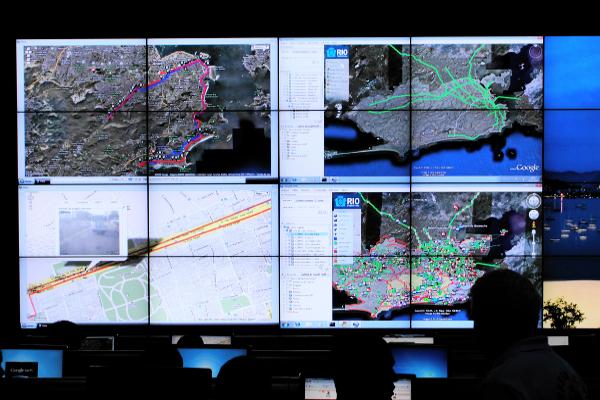
Rio Operations Centre: The incident commander's view provides a summary of everything happening around the city on a video wall, including surveillance cameras, maps, simulations, news updates, resources and information about incidents
Improving New York City's transport system
NYC is also a leading smart city, and is using data to better assess how it should introduce new infrastructure in its transport system.
“We have something called the Traffic Information System, managed by the Department of Transportation. What they’ll do is request traffic studies and gather all the data available about an intersection [to assess] whether they will develop an intervention for it, whether they want to put in new markings, or to remove or add a lane, add a bike lane, or add a pedestrian marking – something like that,” says Nicholas O’Brien, acting chief analytics officer for the City of New York.
“So they will put additional traffic count monitors there, and take data from the taxi cabs that are sending out GPS signals to determine how quickly they are moving through there and where the potential problems are.”
The city is also doing a proof of concept to apply machine learning to its traffic cameras for car and pedestrian counts to better plan interventions on its streets.
The city is also using microtargeting in its 'Notify NYC' system for emergency notification. For example, it is able to geolocate specific alerts to mobile phones to notify people in the relevant area that a child has gone missing, or there’s a major weather event coming.
“It’s still early stages in determining what we can do with the information coming from phones. And right now we have a lot of privacy concerns around it,” says O’Brien.
IoT, M2M challenges
Standardisation and interoperability are still challenges many infrastructure companies in Australia and around the world are trying to wade through when it comes to building a smart city.
Smart Grid Australia's Budde says the smart meter rollout in Victoria is an example of this. “What you now see in Victoria with the smart meter rollout is the various energy operators are using different smart meters that are not interoperable,” he says.
“If you are a retailer across several of those organisations, you cannot find what is the best solution for one of your customers because you have to go through three different systems. So how smart is that? I think interoperability is one of the key issues in machine-to-machine and Internet of Things.”
NICTA’s Vitsounis agrees that disparate systems make data sharing a challenge, using the example of Port Botany and how trust can be an issue when it comes to the various people sharing data.
“You always have various interactions, various players that have to coordinate. But at the same time they are also competitors and each one has to define its own competitive advantage. It takes time, you need to build the relationships to be a trustworthy party and get this data.”
NICTA’s future logistics living lab leader, Neil Temperley, adds that there’s a human aspect to building a connected and integrated supply chain around dealing with concerns about confidentiality and commercial information.
“They all need to be educated and have a vested interest in sharing information with their partners, their team – they are a team, but they may not realise it – to work together to keep things flowing as efficiently as possible. You can’t just take your own information and play in your own space.”
Access to open data is another challenge. Budde says there is still reluctance by the Australian government to provide free access to data. This could be due to issues around data quality, for example, or it could be that there is a closed culture among some agencies.
The data.gov.au website has collected 3,514 data sets since it first launched in 2011. In comparison, the US data.gov website holds 105,257 data sets since its 2009 launch. Communications Minister Malcolm Turnbull has also pointed out that the government is playing catch up when it comes to making its data publicly available.
“We need a change of mind in government. You see already with the real-time transport applications that the benefits are enormous if you open up the data that governments have,” Budde said.
Ensuring there will be strong broadband and wireless connectivity in future is also key to building a smart city. Budde says we have wireless connectivity “pretty well covered” in Australia, but “always more can be done”.
“When you talk about the Internet of Things, you really talk about billions of sensors that suddenly have to be linked to the network and that then requires a whole new level of networking – street lamps, parking meters, and so on all need to be linked to the wireless network,” he says. “Going forward, more and more investments are needed.”
O’Brien says it is a challenge to support billions of sensors in a city, all feeding off the wireless Internet network. “We are living in the future but not that far in the future where it’s no real cost to handle 20 billion data points a week, which is what our taxi cabs are sending out.”
Follow Rebecca Merrett on Twitter: @Rebecca_Merrett
Follow CIO Australia on Twitter and Like us on Facebook… Twitter: @CIO_Australia, Facebook: CIO Australia, or take part in the CIO conversation on LinkedIn: CIO Australia
Join the CIO Australia group on LinkedIn. The group is open to CIOs, IT Directors, COOs, CTOs and senior IT managers.
